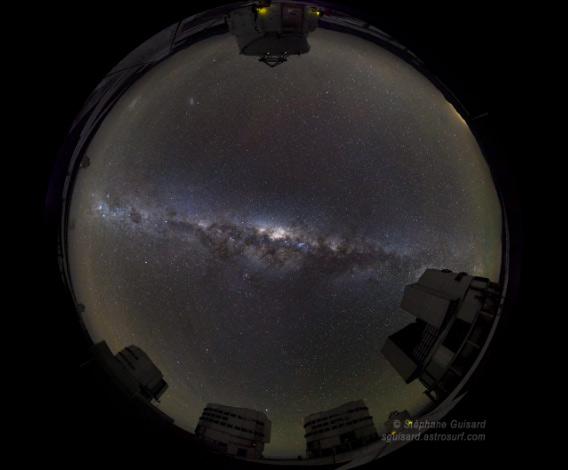Here it is, your moment of Zen: the Milky Way rising majestically over the Paranal Observatory in Chile.
This time-lapse video was taken by Stéphane Guisard, whose photos have been seen on this blog many times before (see Related Posts, below). Guisard used a wide-angle fish-eye lens to capture the whole sky. Around the bottom are the various telescopes comprising the Very Large Telescope array (each an 8.2-meter behemoth), and you can see the domes moving as they target various astronomical objects.
The Milky Way steals the show here. We live in a vast disk galaxy, 100,000 light-years across. But we’re not in the center; we’re very roughly halfway from the center to the edge of the disk. That means when we look toward the constellation of Sagittarius, we are looking toward the center of the galaxy—like someone who lives halfway to the northern edge of Manhattan can face south to look “downtown.”
The central bulge of the galaxy rises right to the zenith, and the flat disk, seen edge-on, bends due to the weird optical effect of the lens Guisard used. The disk is littered with gas clouds and spotted with darker clouds of thick dust that block the light of stars behind them.
Two satellite galaxies, the Large and Small Magellanic Clouds, rise to the upper left as airplanes streak across the frame. My favorite part, though, is right at the end, when coming in from the upper right you can see a faint shaft of light pointing toward the center of the frame. That’s zodiacal (pronounced Zo-DIE-ah-cull) light, sunlight reflected by dust shed from comets in the solar system. Like the Milky Way itself, those particles form a flat disk that we see edge-on, so it looks like a line across the sky. It’s very faint, and you need really dark skies to spot it at all.
I’ve never been to Paranal, but someday I hope I will. I can only imagine how incredible the view must be from down there.
Related Posts
To Surf a Hundred Million Stars
The Ruins of Past, Present, and Future
The Lines in the Sky Are Stars
Time-lapse: Old Rocks and Old Stars
Time-Lapse: The Spectacle of Comet Lovejoy
